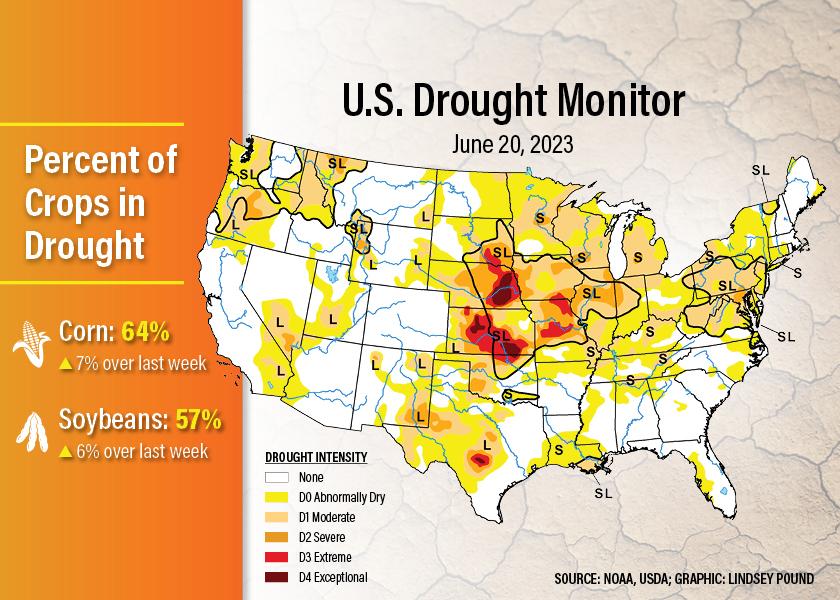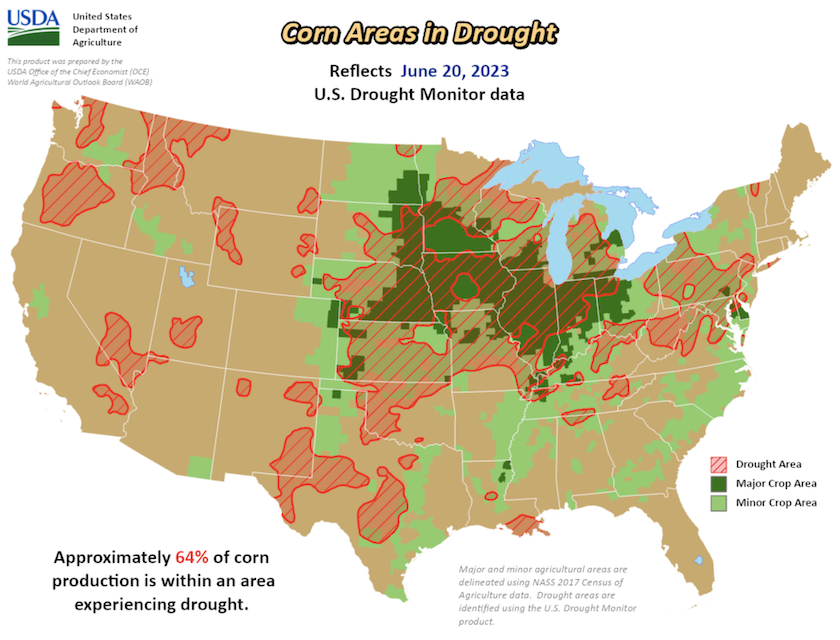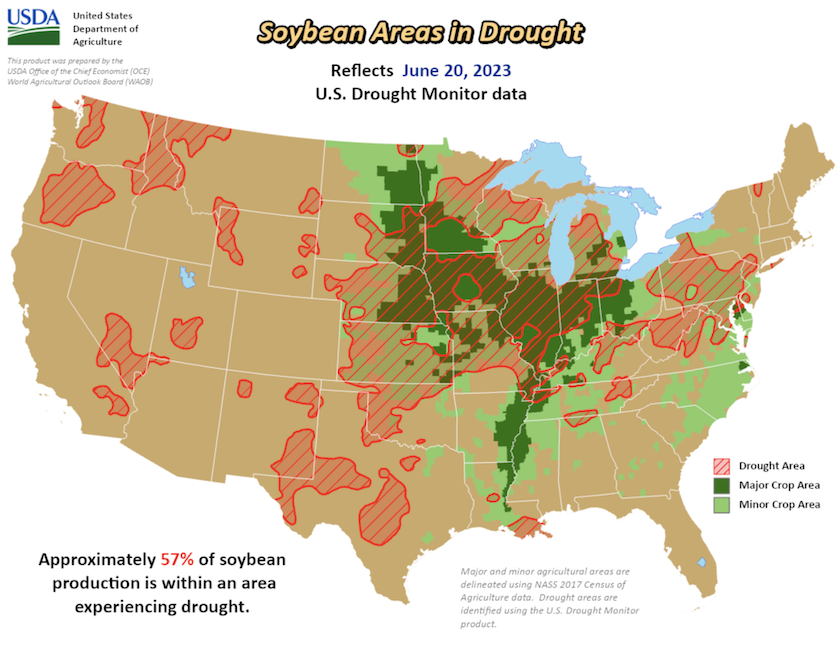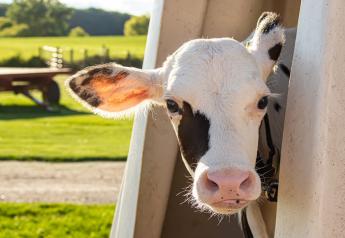Drought Watch: 64% of U.S. Corn Crop Now Covered by Drought

Drought continues to be a major story for farmers this year, and new data shows drought conditions are deepening across the Midwest. According to the National Drought Mitigation Center, 64% of the corn crop and 57% of the soybean crop across the U.S. are now covered in drought. That’s a sizable jump in just a week, which is reflected in the ongoing decline in crop conditions.
According to the U.S. Drought Monitor released Thursday, despite near to below normal temperatures, a lack of rainfall means drought conditions are expanding across the Midwest:
- D1 (Moderate Drought) jumped 9.77 points to 58.49%
- D2 (Severe Drought) increased 7.95 points to 15.91%
- D3 (Extreme Drought) inched up 1.38 points, to 2.59%

“As a result, short-term (30 to 90 day) dryness continued to worsen, leading to widespread deterioration,” the weekly monitor states. “The exception to this was across the eastern Corn Belt and into parts of Kentucky, where seven-day rainfall totals helped to improve drought conditions, or at least halt further degradation. Ohio is the greatest beneficiary of the heavy rains this week and saw the most improvement, with several areas receiving more than 2" of rainfall.”
Weekly Condition Ratings See Largest Drop to Lowest in 30 Years
The weekly decline in USDA-NASS crop progress report has been significant, and this week also saw notable drops. Nationally, USDA-NASS says 55% of the corn crop is rated good to excellent. Lance Honig, NASS Crops Branch Chief, says there are only two years in history where condition ratings have been lower for this week: 1992, when 52% of the crop was rated good to excellent and 1988 with a 37% good to excellent rating.

When comparing the weekly drop in ratings, Honig says the a six-point drop in U.S. corn condition ratings marks the largest drop in ratings for this week since 2007.
“Generally speaking, we've seen some declines really all along this year since ratings started several weeks ago,” Honig says. “It’s not terribly uncommon to start high and see a bit of a decline those first few weeks, but the magnitude of decline that we've seen kind of week after week has been a little bit greater than what we would normally expect to see. In fact, just this past week, in particular, nationally it doesn't always seem like that much to see a five or six percentage point drop in your good to excellent rating, but generally speaking, we don't see that much nationally in just a week's time. And so it's not unheard of, but it's certainly not terribly common.”
When you break the ratings down state-by-state, Honig points out there were some considerable drops specifically in several of the key Corn Belt states, and if you compare the week of June 19 to the same point in history, you have to go back 30 years to find declines this significant.
According to Honig, the most significant drops in ratings include:
- Illinois: down 12 points; only 2007 larger (down 21 points) / at 36%; only 1992 lower (28%)
- Iowa: down 11 points; largest drop since 1991 / at 59%; 2021 was 56%
- Wisconsin: down 16 points; largest drop for this week / at 50%; only lower in 1992 (37%) and 1993 (28%)
- North Dakota: down 14 points; largest drop for this week
- South Dakota: down 12 points; largest drop since 1993 / at 48%; only lower in 2021 (34%)
Read More: Production Problems in the Eastern Corn Belt? A Look at NOAA's New Summer Drought Outlook
Many of the areas seeing conditions continue to crumble are states where farmers had favorable planting conditions, mainly the eastern Corn Belt. Honig says once the rains shut off, the crop condition situation changed in a hurry.
“From a trend aspect, they're certainly heading in the wrong direction. But when you talk about condition, ratings and yield, you do have to be careful not only because of timing but just in general, condition ratings, there is some correlation with yield, but it's not a direct correlation, or at least not always,” Honig says. “And so you have to be very careful about looking at these condition ratings now and trying to forecast what you think the final yield is going to be.”
Soybeans Slip
Nationally, the soybean crop is 54% good to excellent, and Honig says there are only two years where soybean conditions were rated lower for this week: 1992 at 51% good to excellent and 1988 where 23% of the crop was in the top two categories.
Honig says the soybean crop ratings dropped five points in one week, the largest drop for this week since 2007.
The state-by-state breakdown by Honig shows:
- Illinois: down 14 points; largest drop since 2007 (down 15 points) / at 33%; only lower in 1992 (30%)
- Iowa: down 10 points; largest drop since 1998 (down 14 points) / at 56%; lowest since 2008 (49%)
- Wisconsin: down 10 points; largest drop since 2008 (down 14 points) / at 52%; only lower in 2013 (50%)
- North Dakota: down 11 points; largest drop / at 53%; lower in 2021 (23%) and 2002 (52%)
- South Dakota: down 11 points; only larger drop in 2021 (down 12 points) / at 50%; lower in 2021 (33%) and 2017 (48%)

Honig says especially with soybeans, it’s important to remember rains could still have a big impact on the crop.
Subsoil Moisture Shows Desperate Need for Rain
The weekly Crop Progress report also tracks subsoil moisture, showing the moisture is severely depleted across some Corn Belt states. In Illinois, 83% of the subsoil is considered short to very short of moisture. In Michigan, the reading is 89%.

It will take more than one rain to replenish the subsoil moisture, but rains would help. And Honig says it’s not time to declare the U.S. corn and soybean crop a disaster yet.
“You can have a lot of problems early, and certainly it has an impact. I don't want to suggest that having problems early doesn't have an impact, but you still got time to make up for some of these impacts or to offset some of these impacts,” Honig says. “And even if it wasn't just the making up aspect of it, there are certain stages of development that just really need moisture, a lot more. And we're not at that stage yet.”
Honig says the stage is set for potential production problems, and it’s something NASS will watch closely from week to week.







